Unit - 5
AC Series Motor
Q1) Explain the effect of operating DC series motor on AC supply?
A1)
1) An AC supply will produce a unidirectional torque because the direction of both the currents (i.e., armature current and field current reverses) at the same time.
2) Due to presence of alternating current, Eddy currents are induced in the yoke and field course which result in excessive heating of the yoke and field cores.
3) Due to the inductance of the field and the armature circuit, the power factor would become very low.
4) There is sparking at the brushes of the DC series motor.
Thus, considering above points we can say that we don't have good performance of DC series motor on the application of AC supply. There need some modifications
Q2) What modification are required to operate DC series motor on AC supply?
A2)
a) In order to reduce the Eddy currents there is need to laminate the yoke and field core.
b) The power factor is directly related to reactance of the field and armature circuit and we can reduce the field winding reactance by reducing the number of turns in the field winding. But on reducing the number of turns, field MMF will decrease and due to this the air gap flux will decrease. The overall result of this is that there is an increase in the speed of the motor but decrease in the motor torque which is not desired.



The solution to this problem is the use of compensating winding.
c) The number of armature conductors is increased in order to get the required torque with the low flux.
Q3) Explain with phasor diagram, the compensated series motor.
A3)
Compensated series motor
Construction-:
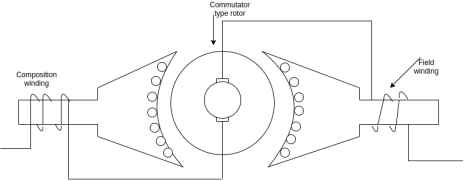
The armature of AC series motor is same as ordinary series motor. In order to minimise commutation problems, high resistance brushes with increased brush area are used. The stator core and yoke are laminated to reduce Eddy current loss produced by alternating flux. The machine is generally operated at a lower flux density using very short air gaps.
- Conductively compensated type motors
In this type of motor, the compensating winding is connected in series with the armature circuit. The winding is put in the stator slots. The axis of the compensating winding is 90° with the main field flux.
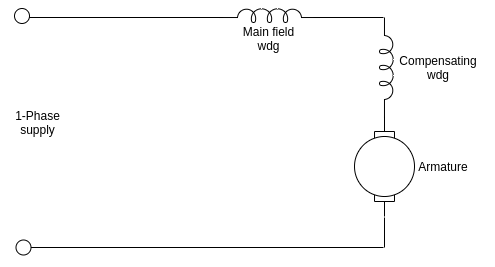
b. Inductively compensated type motors
In this type of motor, the compensating winding has no interconnection with the armature circuit of the motor.
In this case a transformer action takes place as the armature winding will act as primary winding of the transformer and the compensating winding will acts as a secondary winding.
The current in the compensating winding will be in phase opposition to the current in the armature winding.

Complete schematic diagram of the single phase AC series motor with all the modifications.

The main function of the inter poles is to improve the performance of the motor in terms of higher efficiency and a greater output from the given size of the armature core.
Ratings and applications
Portable drills, hair dryers, table fans, kitchen appliances etc.
These motors found in the range of 1000W.
Phasor diagram
The circuit diagram of a compensated AC series motor is shown in figure. The MMF produced by the compensating winding opposes the quadrature axis mmf produced by the armature current.
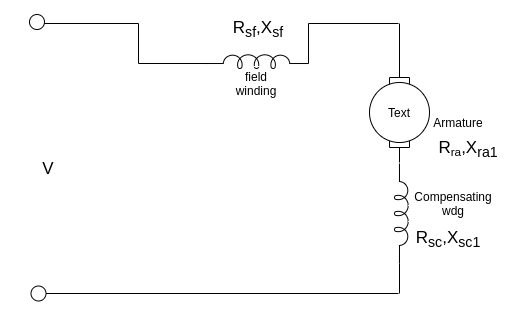
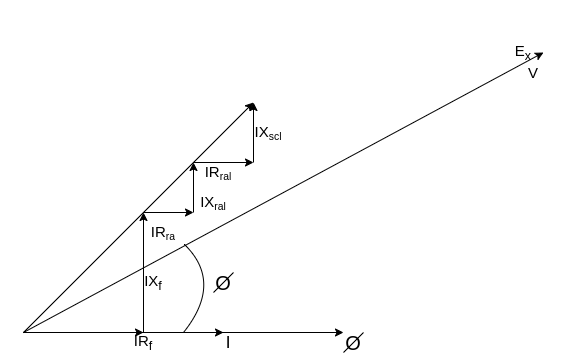
Where
 =field resistance
=field resistance
 = field reactance due to its self inductance
= field reactance due to its self inductance
 = armature resistance
= armature resistance
 =armature leakage reactance
=armature leakage reactance
 =compensating winding resist.
=compensating winding resist.
 = leakage reactance of compensator.
= leakage reactance of compensator.
 = rotational EMF
= rotational EMF
If the same motor is supplied with DC, the voltage equation is given by

Q4) Draw and explain the torque-speed characteristics of AC series motor, also state some applications of AC series motor.
A4)
The torque speed characteristics of an AC series motor are similar to that of a traditional DC series motor.
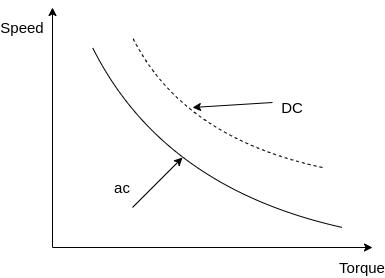
The performance characteristics with variation of armature current are shown in below figure.
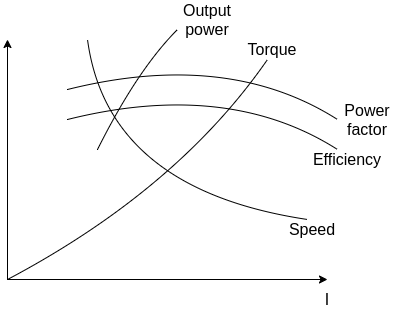
Applications
Single phase AC series motor has high starting torque. They are used in electric Railways with power ratings to 2200 HP, voltage range from 220 V to 600 V and frequency from 15 to 25 Hz.
Fractional horsepower single phase AC series motor are used for domestic and industrial application.
For such applications, motors of rating 115 V to 230 V, frequency of to 60 Hz and speed 3000 rpm to 18000 rpm are used.
Q5) A universal series motor has a resistance of 30 Ω and an inductance of 0.5 H. When connected to a 250 V DC supply and loaded to take 0.8A it runs at 2000 rpm. Determine the speed, torque and power factor when connected to a 250 V, 50 Hz AC supply and loaded to take the same current.
A5)
Operation of motor on DC

=250-0.8×30
=226 V

Operation of motor on AC



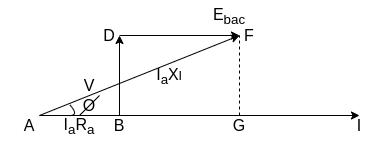
From the phasor diagram








Since currents in dc and ac operation are equal, the flux will also be equal (




Power factor=

 lagging
lagging
Mechanical power developed



Torque developed




Q6) Write a short note on universal motor.
A6)
Universal motor-:
A series motor designed for operation on DC does not show good performance when operated on AC.
Small fractional bp what is known as universal motors are widely used for food mixers, vacuum cleaners, hair dryers, electric shavers, portable drills, sewing machines etc.
They are ac series motors generally without compensating winding and can be used on both AC and DC.
They have ratings: below 0.75 HP and have high operating speed of around 7000 rpm or so.
The high speed results in a small weight and size of the motor. The friction and windage losses are sufficient to limit the no load speed to a safe value.
Armature current is small, so that serious commutation problems are eliminated.
In a universal motor the q axis field created by armature current is also present in addition to the Direct axis field  created by the series field winding.
created by the series field winding.
In an AC series motor with compensating winding the q axis field is neutralized by the effect of compensating winding.
Both these fields alternate at supply frequency. Each of these field sets up rotational EMF and transformer EMF.
The d axis flux  creates a rotational EMF across the brushes. In a DC machine this EMF E is
creates a rotational EMF across the brushes. In a DC machine this EMF E is

Q7) Derive the emf equation of universal motor.
A7)
In a DC machine this EMF E is

Where  =Flux per pole
=Flux per pole
Z=number of armature conductors
P=number of poles
A=number of parallel paths
n= speed, revolutions/second
The frequency corresponding to speed n is 
Therefore,

If flux  is alternating i.e.,
is alternating i.e.,  , the instantaneous value of rotational EMF
, the instantaneous value of rotational EMF  is
is

And the rms value  is
is

This EMF is in phase with flux 
Since flux  is alternating flux, transformer EMF is also induced in armature coils. This EMF adds to zero at the brushes.
is alternating flux, transformer EMF is also induced in armature coils. This EMF adds to zero at the brushes.
The q axis flux  (created by armature coils) also sets up rotational and transformer EMFs. The transformer EMF due to this flux
(created by armature coils) also sets up rotational and transformer EMFs. The transformer EMF due to this flux  Is
Is

Where
 =RMS value of transformer EMF, volts.
=RMS value of transformer EMF, volts.
f=supply frequency
 =breadth factor (since the armature winding is distributed in slots)
=breadth factor (since the armature winding is distributed in slots)
If 

Since  is alternating at the supply frequency f, it induces a transformer EMF in the field winding which is a concentrated winding of
is alternating at the supply frequency f, it induces a transformer EMF in the field winding which is a concentrated winding of  turns. This EMF is given by
turns. This EMF is given by

This EMF is in quadrature with flux  therefore,
therefore,  and
and  are in phase. Both these EMF are proportional to and in quadrature with current I. Therefore, it is possible to write
are in phase. Both these EMF are proportional to and in quadrature with current I. Therefore, it is possible to write  , where X is a constant of proportionality and has the dimensions of reactance.
, where X is a constant of proportionality and has the dimensions of reactance.
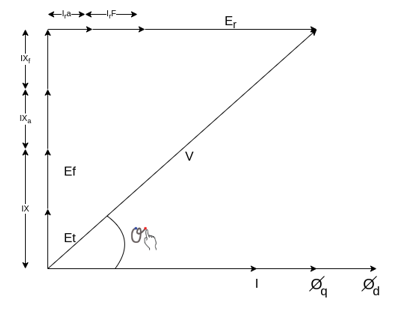
Q8) A 2 pole, 50 HZ, 230 volt universal motor has 1200 armature turns and 400 series field turns. When operated on AC, the full load current is 1 A, field flux is 0.0008 weber and speed is 7000 rpm. The total resistance and leakage reactance are 20 ohm and 30 ohm respectively. Find
a) Transformer EMF induced in the armature winding by the quadrature flux
b) Quadrature flux
And takes 1 A. The armature is wave wound.
A8)
a) 
A=2, Z=1200*2,



=158.37V


=71V
The phasor diagram is shown below
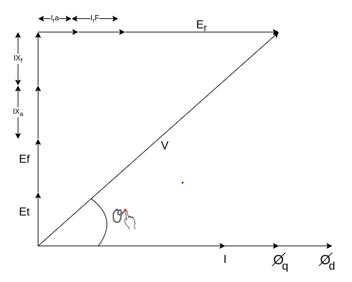



b) 


Q9) A 2 pole, 50 HZ, 230 volt universal motor has 1200 armature turns and 400 series field turns. When operated on AC, the full load current is 1 A, field flux is 0.0008 weber and speed is 7000 rpm. The total resistance and leakage reactance are 20 ohm and 30 ohm respectively. Consider 
Find
a) HP output
b) Speed of operation if machine is connected to DC supply and takes 1 A. The armature is wave wound.
A9)


=0.814
 lagging
lagging
Power input=


Copper losses =

Neglecting other losses=power output=178.48-20
=158.48 watt

When connected to DC supply


=230-20
=210V



=9282 rpm
Q10) A 2 pole, 50 HZ, 230 volt universal motor has 1200 armature turns and 400 series field turns. When operated on AC, the full load current is 1 A, field flux is 0.0008 WB and speed is 7000 rpm. The total resistance and leakage reactance are 20 ohm and 30 ohm respectively. Motor takes 1 A current. The armature is wave wound. The Motor is provided with a compensating winding having a resistance of 2 ohm and reactance of 5 ohm. The compensating winding neutralizes armature flux completely. Find the speeds of operation on AC and DC if V=230V and I=1A.
Consider 
A10)
Since  has been neutralized fully
has been neutralized fully




If  is the new speed for AC operation
is the new speed for AC operation


When connected to DC supply





Q11) A universal series motor has a resistance of 30 and an inductance of 0.5 H. When connected to a 250 V dc supply and loaded to take 0.8 A it runs at 2000 rpm. Determine the speed, torque and power factor, when connected to a 250 V, 50 Hz ac supply and loaded to take the same current.
A11)
Operation of motor on dc
Ebdc = V-IaRa = 250-0.8 x 30 = 226V
Ndc = 2000rpm
Operation motor on ac
XL = 2πfL = 2πx 50x0.5=157
From phasor below we get







Since the currents in dc and ac operation are equal, the flux will also be equal ɸac= ɸdc


Power factor  (lagging)
(lagging)
Mechanical power developed

Torque developed

Q12) Compare AC and DC motor?
A12)
AC Motors | DC Motors |
Ac motors are powered from AC current. | DC motors are powered from DC current. |
In AC motors conversion of current is not required | In DC motors conversion of current is required like ac into dc current |
AC motors are used where power performance is sought for extended periods of time. | DC motors are used where motor speed required to be controlled externally. |
AC motors can be single phase or three phase. | All DC motors are single phase. |
In AC motors Armatures do not rotate while magnetic field continuously rotates. | In DC motors, the armature rotates while magnetic field does rotate. |
Repairing of DC motors is costly. | Repairing of AC motors is not costly. |
AC motor does not use brushes. | DC motor uses brushes. |
AC motors have a longer life spam. | DC motors have not a longer life spam. |
Speed of AC motors is simply controlled by varying the frequency of current. | Speed of DC motors is controlled by varying the armature winding's current. |
AC motors require an effective starting equipment like capacitor to start operation. | DC motors do not require any external help to start operation |
Q13) Determine torque established by the armature of six pole DC motor having 680 conductors, two paths in parallel, 24mWb flux/pole and armature current 50A?
A13) 

T= x24x10-3x50x680x (4/2) =259.74 N-m
x24x10-3x50x680x (4/2) =259.74 N-m
Q14) A 220V DC Shunt motor runs at 450rpm when armature current is 39A. Calculate speed if the torque is doubled. The armature has a resistance of 0.2 ohm?
A14)
Ta α φIa
Ta1 α φIa1 and Ta2 α φIa2
2= Ia2/39
Ia2=78A
N2/N1=Eb2/Eb1
Eb1=220-(39x0.2) =212.2Volts
Eb2=220-(78x0.2) =204.4Volts
N2/450=204.4/212.2
N2=433.46 rpm
Q15) A 4 pole, 210 V shunt motor has 450 lap wound conductor. It takes 32 A from supply mains and develops output power of 4.5 kW. The field takes 1 A. The armature resistance is 0.09 ohm and flux per pole is 30 mWb. Calculate speed and torque.
A15)
Ia = 32-1 = 31 n
Eb = V – Ia Ra = 210 - (0.09×31) = 207.21 V


N = 920.9 rpm


Q16) A 220 V, dc shunt motor has an armature resistance of 0.3 ohm and field resistance of 105 ohm. At no load speed is 1200 rpm and armature current is 2.3 A on application of rated load speed drops to 1120 rpm. Find the current and power input when motor delivers rated load.
A16)
N1 = 1200 rpm Eb1 = 220 – (0.3×2.3) = 219.31 V
N2 = 1120 rpm Eb2 = 220 – 0.3 Ia2


Ia2 = 37.93 A
Line current = Ia2 + Ish = 37.93 + (220/105) = 40 A
Power input = 220 × 40 = 8800 W
Q17) A 230 V shunt motor runs at 1000 rpm at no load and takes 6A. The total armature resistance is 0.2 ohm and field resistance is 210 ohms. Calculate the speed when loaded and taking 40 A. Assume flux constant.
A17) 






Q18) The armature resistance of a 15 kW, 230 V series motor is 0? 1 ohm, the brush voltage drop is 3 V and series field resistance is 0.05 ohm. The motor takes 60 A speed is 600 rpm. Calculate speed when current is 100 A.
A18)



Φ1  60
60
Φ2  100
100



N2=350.22 rpm
Q19) A 230V DC Shunt motor takes 4A at no load when running at 600 rpm. The field resistance is 100 ohms. The resistance of armature at standstill gives a drop of 6V across armature terminals when 10A were passed through it. Find i) Speed at no load (ii) Torque. Normal input of motor is 6kW
A19)
i)Speed 
Ish=  =2.3A
=2.3A
F.L Power=6000
F.L line current=  =26.08A
=26.08A
Ia=26.08-2.3=23.78A
Ra= =0.6Ω
=0.6Ω


N=566.2 rpm
Ii)Torque  =
=
